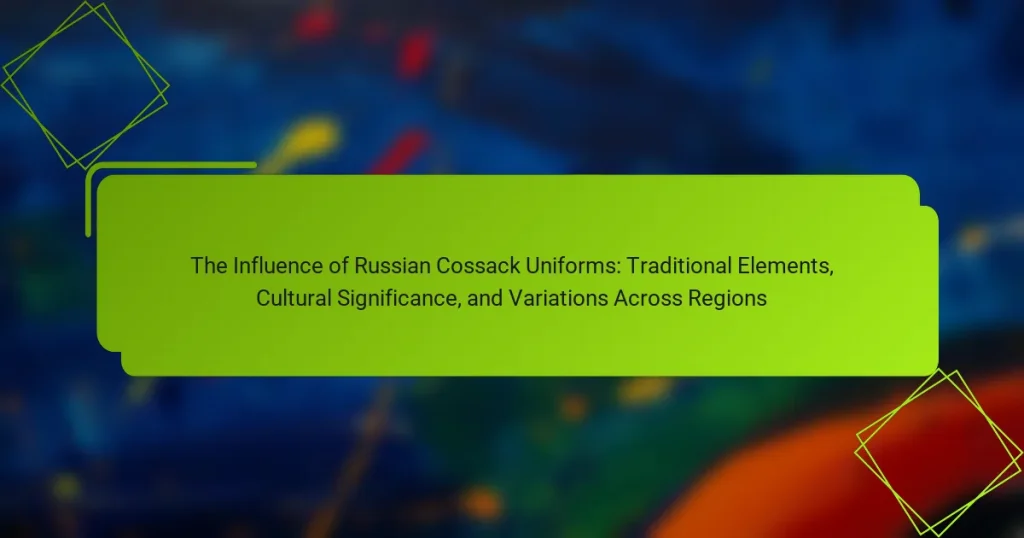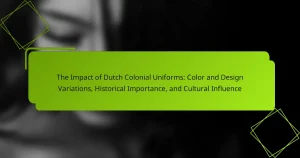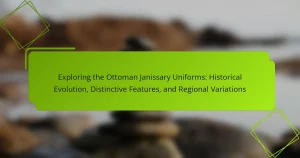Russian Cossack uniforms are traditional garments that symbolize the cultural identity and military heritage of Cossack communities in Russia and Ukraine. These uniforms, which have evolved from practical military attire to elaborate outfits, include key elements such as the cherkesska, a long coat often featuring intricate embroidery, and the papakha, a fur hat indicating rank. The historical significance of these uniforms dates back to the 15th century, reflecting both functionality in battle and representation in ceremonial contexts. Regional variations exist among different Cossack hosts, such as the Don, Kuban, and Terek, each showcasing unique designs and colors influenced by local traditions. Today, these uniforms serve as important symbols of Cossack heritage, often worn during cultural festivals and events, highlighting their ongoing relevance in contemporary society.

What are Russian Cossack Uniforms and their Historical Context?
Russian Cossack uniforms are distinctive garments worn by Cossack communities in Russia and Ukraine. These uniforms symbolize the cultural identity and military traditions of the Cossacks. Historically, the uniforms evolved from practical military attire to elaborate outfits reflecting social status.
Cossack uniforms typically include a long coat called a “cherkesska” and a wide belt. The cherkesska is often adorned with intricate embroidery and distinctive colors. The attire also features a “papakha,” a traditional fur hat, indicating rank and regional affiliation.
The historical context of these uniforms dates back to the 15th century. Cossacks were known for their military prowess and played significant roles in various conflicts. Their uniforms were designed for both functionality and representation in battle and ceremonial events.
The evolution of the Cossack uniform reflects broader societal changes. Over time, influences from the Russian Empire and neighboring cultures shaped the design and materials used. The uniforms remain a symbol of Cossack heritage and pride today.
How did Russian Cossack Uniforms originate?
Russian Cossack uniforms originated in the 15th century among the Cossack communities of Southern Russia. These uniforms were influenced by a mix of local traditions and military needs. Initially, they featured practical designs suitable for horseback riding and combat. The attire often included elements like the cherkesska, a long coat with a high collar. Over time, distinct regional variations emerged, reflecting local customs and climates. The adoption of specific colors and insignia also developed to signify different Cossack groups. Historical records indicate that these uniforms became symbols of identity and pride for the Cossacks. By the 18th century, the uniforms were standardized for military purposes within the Russian Empire.
What historical events influenced the development of these uniforms?
The development of Russian Cossack uniforms was influenced by several historical events. The Cossacks emerged in the 15th century as free warrior communities on the frontiers of the Russian Empire. Their uniforms evolved during the various military campaigns against the Ottoman Empire and the Polish-Lithuanian Commonwealth. The incorporation of elements from these conflicts led to distinctive features in their attire, such as the use of fur and colorful embroidery. The establishment of the Cossack Host in the 16th century formalized their military role, necessitating standardized uniforms. Additionally, the reforms of Peter the Great in the 18th century introduced Western military influences, further shaping their uniforms. The uniforms also reflected regional variations due to local customs and climates, demonstrating adaptability. These historical contexts collectively contributed to the rich tapestry of Cossack uniform development.
What are the key historical figures associated with Cossack uniforms?
Key historical figures associated with Cossack uniforms include Hetman Bohdan Khmelnytsky and Ataman Ivan Mazepa. Bohdan Khmelnytsky was a prominent leader in the 17th century who played a significant role in establishing the Cossack state. His leadership influenced the design and symbolism of Cossack attire. Ataman Ivan Mazepa, another notable figure, led the Cossacks in the late 17th and early 18th centuries. His contributions to military organization and uniformity impacted Cossack military dress. These figures are integral to understanding the evolution of Cossack uniforms and their cultural significance.
What traditional elements are present in Russian Cossack Uniforms?
Traditional elements present in Russian Cossack uniforms include the distinctive papakha hat, which symbolizes Cossack pride. The tunic, known as a cherkesska, features a high collar and is often adorned with decorative elements. Cossacks typically wear wide trousers called sharovary, which allow for ease of movement. The uniform is often completed with a belt, which holds a sabre, a traditional weapon of the Cossacks. Additionally, the use of specific colors and insignia reflects regional identities and historical affiliations. These elements combine to create a unique representation of Cossack heritage and military tradition.
What materials are commonly used in the construction of these uniforms?
Common materials used in the construction of Russian Cossack uniforms include wool, cotton, and leather. Wool is favored for its durability and warmth, making it suitable for colder climates. Cotton is often used for lighter garments, providing comfort and breathability. Leather is utilized for accessories and footwear due to its strength and flexibility. Historical records indicate that these materials were chosen for their practicality and availability in various regions. The combination of these fabrics reflects both the functional needs and cultural heritage of the Cossack community.
What colors and symbols are significant in Cossack uniforms?
Cossack uniforms are characterized by specific colors and symbols that hold cultural significance. The predominant colors include blue, red, and black. Blue symbolizes loyalty and courage. Red represents valor and strength. Black is often associated with mourning or the severity of military duty.
Symbols such as the Cossack cross and the double-headed eagle are also significant. The Cossack cross signifies faith and bravery. The double-headed eagle represents the unity of [censured] and state. These colors and symbols reflect the historical and cultural identity of the Cossacks.
How do Russian Cossack Uniforms reflect cultural identity?
Russian Cossack uniforms reflect cultural identity through their distinct colors, designs, and historical significance. These uniforms often feature elements like the papakha hat and the cherkesska coat. The colors used in the uniforms are representative of regional identities and historical allegiances. For instance, red and black are common, symbolizing courage and strength. Cossack uniforms also incorporate traditional embroidery, showcasing regional craftsmanship and cultural heritage. The style and decoration of these uniforms vary significantly across different Cossack communities, highlighting local traditions. Historically, these uniforms were worn during military campaigns, reinforcing a sense of pride and unity among Cossacks. Overall, the uniforms serve as a visual representation of the Cossack’s cultural legacy and their role in Russian history.
What role do these uniforms play in Cossack traditions and rituals?
Cossack uniforms serve as symbols of identity and heritage in Cossack traditions and rituals. They represent the historical military role of Cossacks in Russian society. The uniforms are often worn during cultural ceremonies and celebrations, emphasizing pride and unity among Cossack communities. Specific elements, such as colors and insignia, convey rank and regional affiliation. The uniforms also play a role in preserving historical narratives and customs. For instance, traditional Cossack attire is showcased during festivals, reinforcing cultural continuity. Additionally, the uniforms are integral to rituals that honor ancestors and celebrate Cossack history. Overall, they embody the spirit and values of Cossack culture.
How are Cossack uniforms perceived in modern Russian culture?
Cossack uniforms are perceived as symbols of historical pride and cultural identity in modern Russian culture. They evoke a sense of nostalgia for the Cossack heritage. Many view them as representations of bravery and loyalty, reflecting the martial traditions of the Cossacks. The uniforms are often associated with folklore and national celebrations. Additionally, they are used in cultural events and reenactments, showcasing their significance in Russian history. The colors and designs of these uniforms carry meanings linked to regional identities. Overall, Cossack uniforms serve as a bridge between past traditions and contemporary cultural expressions in Russia.
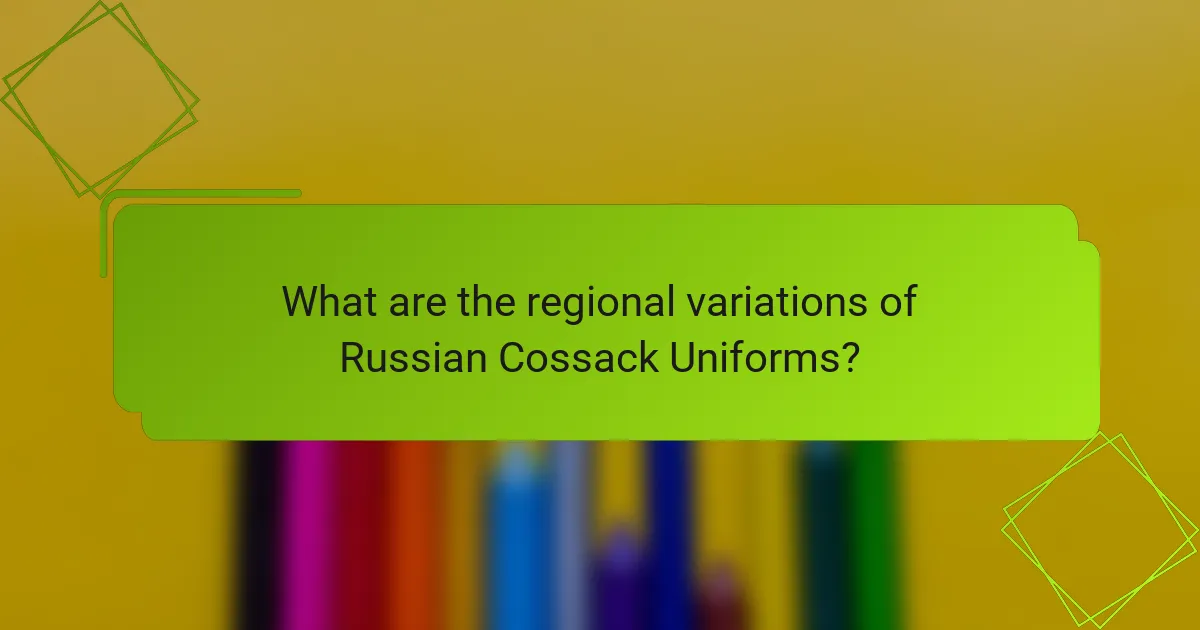
What are the regional variations of Russian Cossack Uniforms?
Russian Cossack uniforms exhibit notable regional variations influenced by local traditions and historical contexts. Each Cossack host, such as the Don, Kuban, and Terek, has distinct uniform elements. The Don Cossacks typically wear dark blue or black trousers with a white shirt and a distinctive papakha hat. Kuban Cossacks often don a lighter uniform with bright colors, reflecting the warmer climate of the region. Terek Cossacks are recognized for their unique use of a high fur hat called a telnyashka. Variations also include differences in insignia, embroidery, and the use of specific materials. Historical conflicts and alliances have further shaped these regional distinctions, making each uniform a representation of local identity.
How do Cossack uniforms differ across various regions in Russia?
Cossack uniforms differ significantly across various regions in Russia. Each region has unique designs influenced by local customs and historical contexts. For instance, the Kuban Cossacks wear a uniform featuring a high collar and distinctive red accents. The Don Cossacks typically have a more straightforward design with blue and black elements. In the Terek region, uniforms often include a fur hat known as a papakha. The uniforms of the Ural Cossacks are characterized by elaborate embroidery and bright colors. These variations reflect the diverse cultural heritage of each Cossack community. Historical events and geographic factors also play a role in these differences. Each uniform serves as a symbol of regional identity and pride among Cossacks.
What unique attributes characterize the uniforms of the Don Cossacks?
The uniforms of the Don Cossacks are characterized by distinct features. They typically include a long, flowing coat known as a ‘cherkesska.’ This coat is often made of wool and has a high collar. Another unique attribute is the decorative elements, such as intricate embroidery and metal buttons. The color scheme is predominantly dark, often featuring shades of blue and black. Cossack hats, called ‘papakha,’ are also a significant part of the uniform. These hats are made from sheepskin and are worn to signify rank. Additionally, the uniforms often include a wide leather belt, which is used to carry weapons. These attributes reflect the historical and cultural significance of the Don Cossacks in Russian history.
What distinguishes the uniforms of the Kuban Cossacks?
The uniforms of the Kuban Cossacks are distinguished by their unique design and color scheme. They typically feature a dark blue or black base with red accents. The use of decorative elements, such as silver or gold embroidery, is common. Additionally, the Kuban Cossacks often wear a distinctive hat called a papakha. This hat is made from sheepskin and is emblematic of their identity. The uniforms also include a sash, known as a kubanka, which is tied around the waist. These elements reflect both military practicality and cultural heritage. The historical context of these uniforms connects to the Cossacks’ role in Russian military history.
What factors contribute to the variations in Cossack uniforms across regions?
Variations in Cossack uniforms across regions are influenced by historical, cultural, and geographical factors. Different Cossack groups have distinct historical backgrounds that shape their attire. Local climatic conditions dictate materials used in uniform construction. Cultural influences from neighboring ethnic groups also play a significant role. Specific regional traditions affect color choices and ornamentation styles. The evolution of military needs over time has led to practical adaptations in uniform design. Social status within Cossack communities can result in variations in embellishments and accessories. Lastly, the political context during different periods influenced uniform styles and regulations. These factors collectively contribute to the rich diversity observed in Cossack uniforms across various regions.
How do local climate and geography influence uniform design?
Local climate and geography significantly influence uniform design by determining material choice, color, and functionality. In colder regions, uniforms often incorporate heavier fabrics for insulation. Warmer climates lead to the use of lighter, breathable materials. Geographic features, such as terrain, affect uniform practicality and mobility. For example, uniforms designed for mountainous areas may include features for ease of movement. Additionally, local traditions and cultural factors can dictate specific colors and styles. Historical examples show that Cossack uniforms varied based on these climatic and geographical influences. This adaptability reflects the need for uniforms to meet environmental demands while maintaining cultural identity.
What cultural exchanges have shaped regional differences in Cossack uniforms?
Cultural exchanges between various ethnic groups have significantly shaped regional differences in Cossack uniforms. The interaction between Cossacks and neighboring cultures influenced the design and materials used. For instance, the influence of Ottoman and Persian styles is evident in the decorative elements and cuts of the uniforms. Additionally, interactions with Ukrainian and Polish cultures introduced distinct colors and embroidery patterns. Historical trade routes facilitated the exchange of fabrics and accessories, leading to diverse regional adaptations. The incorporation of local materials further enhanced these variations. Each Cossack group adapted their uniforms to reflect their unique cultural identity while maintaining core elements. This blending of influences has resulted in a rich tapestry of Cossack uniform styles across different regions.
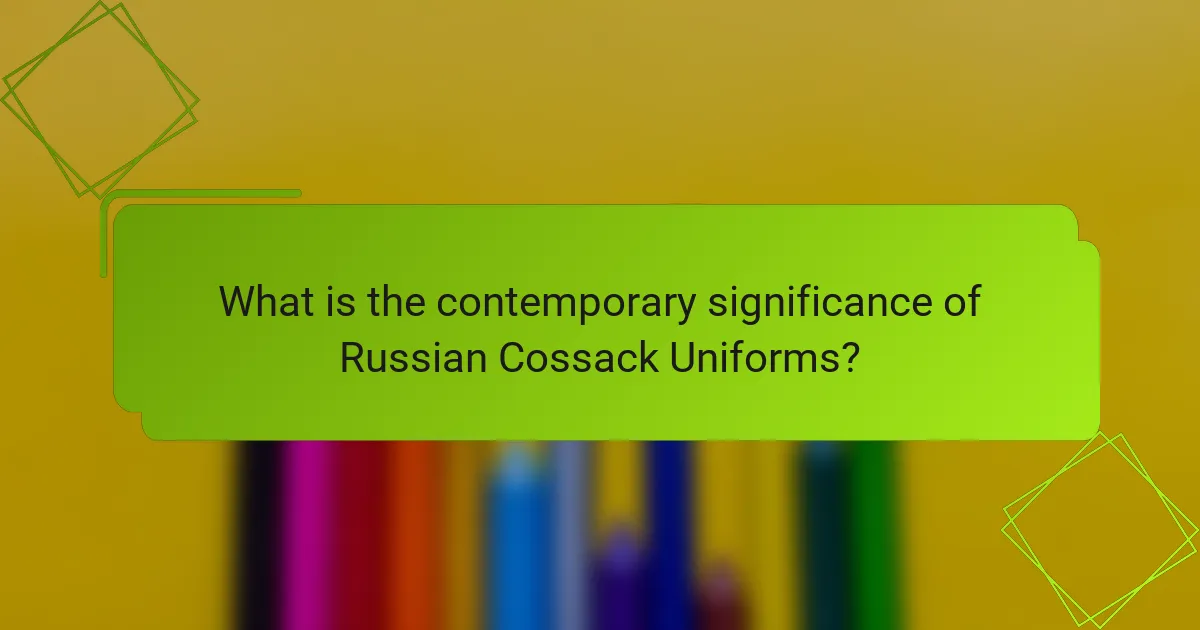
What is the contemporary significance of Russian Cossack Uniforms?
Russian Cossack uniforms hold contemporary significance as symbols of cultural heritage and identity. They represent the historical legacy of the Cossack community in Russia. These uniforms are often worn during cultural festivals and commemorative events. Their distinctive designs reflect regional variations and traditional craftsmanship. The uniforms also serve as a means of preserving Cossack traditions and promoting cultural awareness. In recent years, there has been a resurgence of interest in Cossack culture, leading to increased visibility of these uniforms. This revival highlights the ongoing relevance of Cossack identity in modern Russia. Overall, Russian Cossack uniforms continue to embody a rich cultural narrative that resonates with both history and contemporary society.
How are Cossack uniforms utilized in modern events and celebrations?
Cossack uniforms are utilized in modern events and celebrations to honor cultural heritage. They are often worn during traditional festivals, parades, and commemorative events. The uniforms symbolize Cossack history and identity. Participants showcase their pride in Cossack traditions through these garments. Events like folk festivals feature Cossack dances and music, enhancing the cultural experience. The vibrant colors and unique designs of the uniforms attract attention and interest. Additionally, reenactments of historical events often include Cossack uniforms to provide authenticity. This practice helps educate the public about Cossack history and culture.
What role do these uniforms play in cultural festivals and parades?
Cossack uniforms play a significant role in cultural festivals and parades. They symbolize heritage and identity for the Cossack people. The distinct styles and colors of these uniforms represent various Cossack communities across Russia. Wearing these uniforms fosters a sense of pride and unity among participants. Additionally, they serve to educate audiences about Cossack history and traditions. The uniforms often include unique insignias that denote rank and regional affiliation. Their presence in parades enhances the visual appeal and authenticity of cultural celebrations. Overall, Cossack uniforms are essential for preserving and showcasing cultural heritage during these events.
How do modern Cossack organizations maintain traditional uniform practices?
Modern Cossack organizations maintain traditional uniform practices through adherence to historical designs and ceremonial guidelines. They often source materials that reflect the original fabrics used in traditional uniforms. Many organizations conduct workshops to educate members about uniform history and significance. Regular parades and events showcase these uniforms, reinforcing their cultural importance. Additionally, some groups collaborate with historians to ensure authenticity in uniform details. This commitment to tradition helps preserve Cossack identity in contemporary society. Historical records indicate that the distinct colors and insignias are maintained to honor heritage.
What are the challenges faced in preserving Cossack uniform traditions?
The challenges faced in preserving Cossack uniform traditions include the decline of cultural interest and the loss of traditional craftsmanship. Many younger generations are less engaged with Cossack heritage. This results in fewer individuals learning the skills needed to create authentic uniforms. Additionally, modernization and globalization often overshadow traditional practices. Economic factors can limit access to materials required for uniform construction. Historical conflicts have also disrupted the continuity of Cossack traditions. Furthermore, inconsistent documentation of uniform styles leads to variations that may stray from authentic designs. These factors collectively threaten the preservation of Cossack uniform traditions.
How do societal changes impact the relevance of traditional Cossack uniforms?
Societal changes significantly impact the relevance of traditional Cossack uniforms. As cultural identities evolve, these uniforms may lose everyday functional value. Modernization and urbanization often lead to a decline in traditional practices. Consequently, Cossack uniforms become symbols rather than practical attire.
In recent years, there has been a revival of interest in cultural heritage. This revival fosters a renewed appreciation for traditional Cossack attire. Events like festivals and cultural celebrations showcase these uniforms. Research indicates that such events strengthen community bonds and cultural pride.
Moreover, younger generations may adopt these uniforms for fashion rather than tradition. This shift reflects broader societal trends where heritage is reinterpreted. Thus, while traditional Cossack uniforms may wane in daily use, they gain new significance in cultural expression.
What efforts are being made to educate others about Cossack uniform heritage?
Efforts to educate others about Cossack uniform heritage include workshops, exhibitions, and academic research. Cultural organizations often host workshops to teach traditional Cossack attire-making techniques. Museums display Cossack uniforms and provide contextual information about their historical significance. Academic institutions conduct research on Cossack history, contributing to scholarly articles and publications. Community events celebrate Cossack traditions, promoting awareness among younger generations. Online platforms and social media campaigns also disseminate information about Cossack uniforms. These initiatives aim to preserve and share the rich heritage associated with Cossack attire.
What tips can be offered for understanding and appreciating Cossack uniforms?
To understand and appreciate Cossack uniforms, study their historical context. Cossack uniforms reflect the social and military roles of their wearers. Examine the color schemes, which often signify regional affiliations. Note the distinct features like the papakha hat and the wide trousers. Research the materials used, as they indicate the climate and function. Observe how embroidery and insignia convey rank and heritage. Attend cultural festivals or exhibitions showcasing these uniforms for firsthand experience. Finally, read literature on Cossack history to gain deeper insights into their significance.
Russian Cossack uniforms are distinctive garments that reflect the cultural identity and military traditions of Cossack communities in Russia and Ukraine. The article explores the historical context of these uniforms, tracing their evolution from practical military attire to elaborate outfits symbolizing social status. Key elements such as the cherkesska coat, papakha hat, and regional variations are discussed, alongside the materials, colors, and symbols that characterize these uniforms. Additionally, the article examines the contemporary significance of Cossack uniforms, their role in cultural traditions and rituals, and the challenges faced in preserving this heritage.
